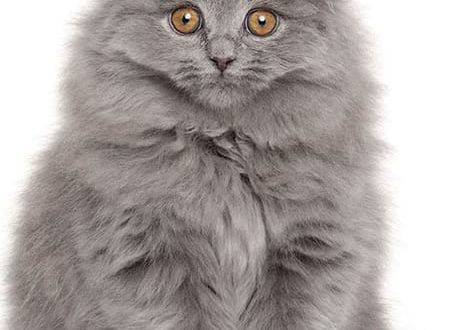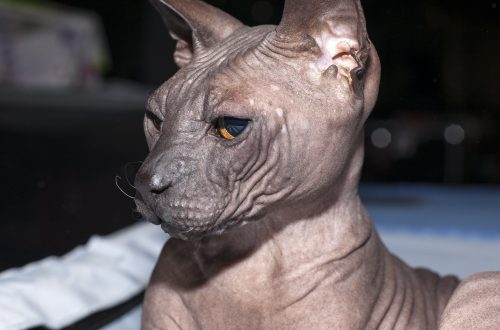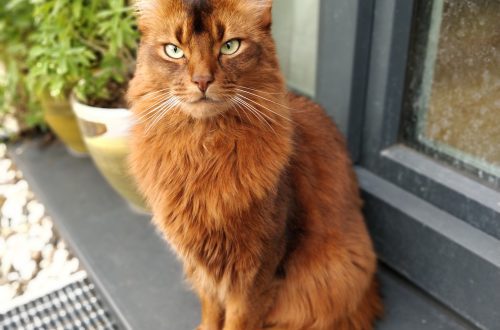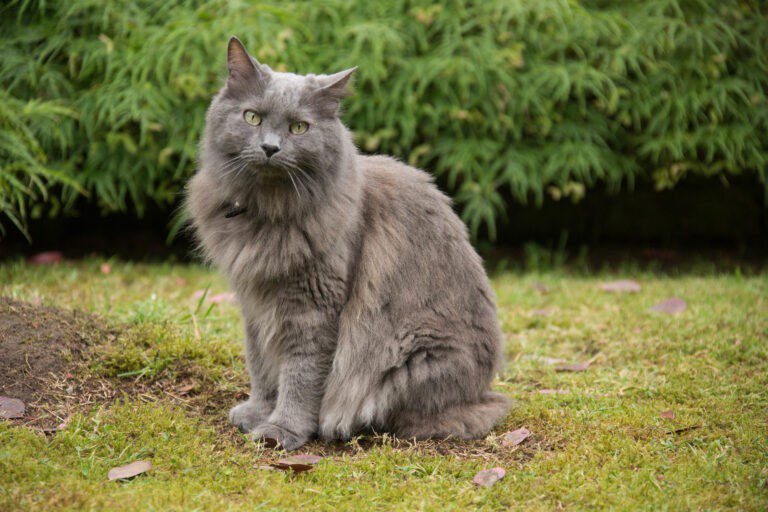
Nebelung
Other names: Russian Longhair
Nebelung is a personable American with the manners of a true gentleman! This handsome man carries himself with royal nobility and demands sincere respect for his feline person.
Contents
Characteristics of Nebelung
| Country of origin | USA |
| Wool type | Longhair |
| Height | 25-28 cm |
| Weight | 3-5 kg |
| Age | 12 to 15 years old |
Basic moments
- The nature of “foggy cats” is an explosive mixture of opposites, but this does not make naughty pets out of animals.
- The Nebelungs are attached to only one member of the family (he is also considered the owner); the rest are friendly, but nothing more.
- These cats are conservative by nature: it is hard to get used to a new environment, they do not like sudden changes in life.
- Representatives of the breed cannot stand loneliness and need constant company, whether it be the owner or a four-legged friend.
- Nebelungs are born hunters, therefore they are not suitable for keeping in an apartment with decorative rodents, birds or aquarium fish.
- Families with small children should not choose “foggy cats”: animals do not tolerate loud noises and disrespectful attitude towards themselves.
- Cats love to learn new tricks and are very trainable with the right approach.
- Nebelungs need careful care, so keeping them can be difficult for a beginner.
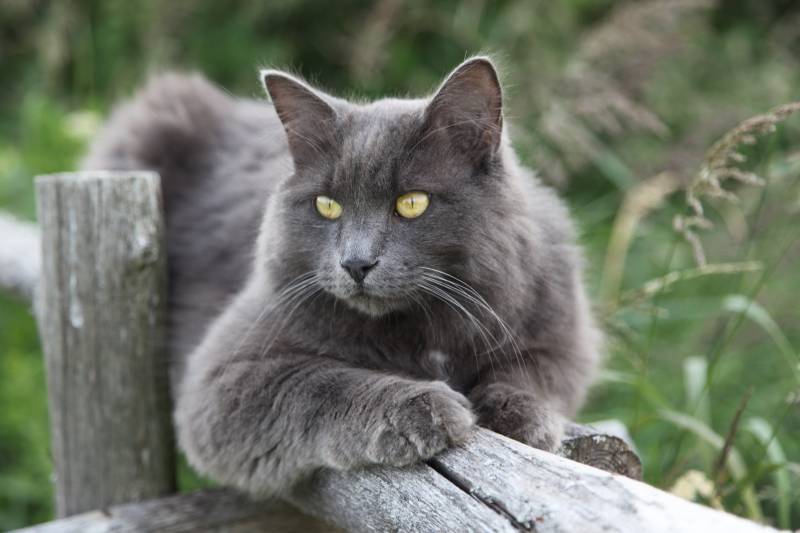
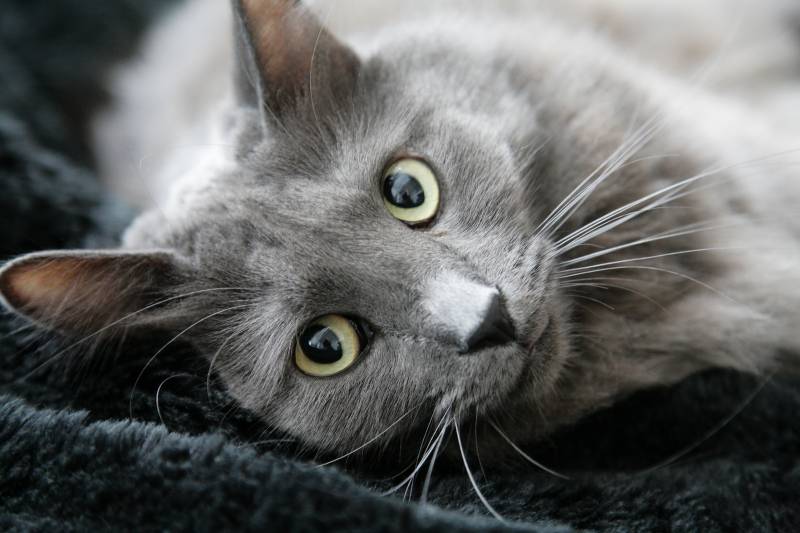
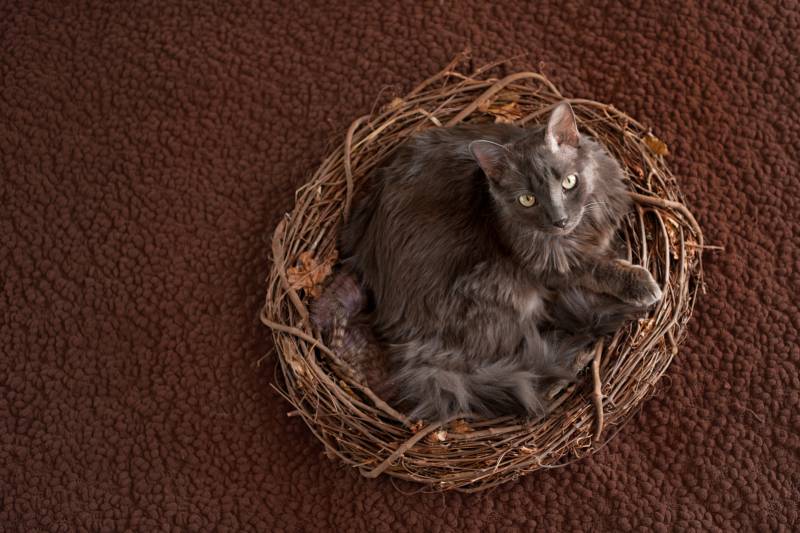
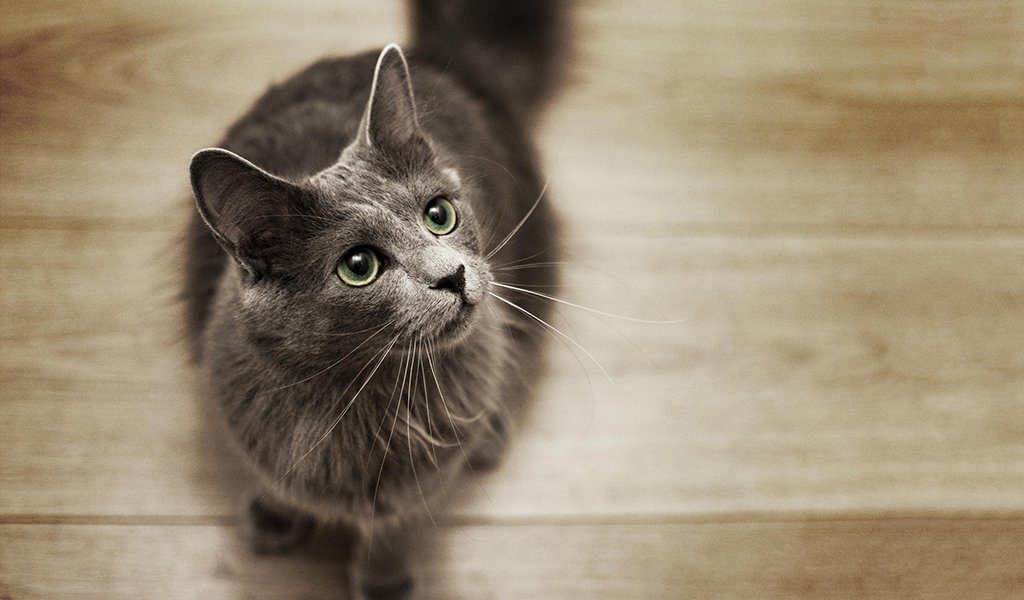
The Nebelung is a rare gem in the world of cat breeds. The first thing that catches your eye when meeting with an animal is its spectacular appearance. A silky coat of bluish-gray color, a gaze of emerald or topaz eyes, perfectly harmonious proportions – it’s hard not to notice such a pet! Despite their proud appearance, the Nebelungs are sociable cats that will not refuse an exciting game. At the same time, representatives of the breed do not impose their company and rarely disturb others with loud meowing. As befits aristocrats, these animals are restrained and well-mannered, do not like company and hardly put up with the company of annoying guests.
History of the Nebelung breed
The Nebelung is a young breed: its first representatives were born in the second half of the last century. The reason for this is an accident: in 1980, the son of programmer Cora Cobb received a black shorthair cat as a gift. Over time, the new favorite of the family named Elsa got along with the Russian blue cat . The result of this union was the birth in 1984 of five babies. Among them, only one was distinguished by an atypically long blue coat. This baby became the favorite of Cora Cobb, who decided to name the pet Siegfried (Sigurd) – in honor of the hero of the medieval German epic “Nebelungenlied”.
In 1985 history repeated itself. This time a baby was born in the litter with a longer and lighter coat than her “predecessor”. The cat was dubbed Brunnhilda, again borrowing the name from a German-Scandinavian source. Since Miss Cobb was fascinated by the beauty and character of the already matured Siegfried, she decided to check whether it was possible to preserve this genotype not only within the litter, but also something more – for example, a new breed. To do this, the woman crossed two long-haired pets. This adventure brought promising results in 1986: Brunnhilda gave birth to three kittens, who fully inherited their unusual appearance from their parents.
Encouraged by the result of crossing, Cora Cobb turned to the International Cat Association (TICA), wanting to use genetics to establish the possibility of creating a breed. Specialist Solveig Pfluger came to the conclusion that Siegfried and Brunnhilde are long-haired representatives of Russian blue cats. Together with Miss Cobb, the geneticist undertook the development of the breed standard. His final version caused a wave of indignation among TICA members and breeders of Russian four-legged beauties. The reason was that there was only one difference between the standards of the blue cat and perhaps the new breed: the length of the coat. In order to avoid conflict, Dr. Pfluger revised the requirements for the exterior of the offspring of Siegfried and Brunhilde. This led to the official recognition of cats by TICA in 1987.
Representatives of the breed were called the Nebelungs. According to one version, this word was borrowed from the name of the medieval Germanic saga Nebelungenlied (from where the names of Cora Cobb’s pets come from). Another theory says that the name of the cats comes from the German word nebel – fog. And indeed: the similarity with this atmospheric phenomenon can be traced in the bluish-silver color of animals.
Russian blue cats were recognized as an outcross for the Nebelungs, which made it possible to cross them to improve the breed. The gene for long hair, which periodically appeared in the generations of blue beauties, was a valuable material for the selection of the Nebelungs. It also became a stumbling block: breeders of Russian cats refused to recognize the new breed and make a contribution to its development. This made it difficult to breed animals, and Cora Cobb was forced to look for a way to continue the line of the Nebelungs.
Luck smiled only in 1988: the owner of the Russian blue cat – the bearer of the title “Supreme Grand Champion” – offered his help. The male was crossed with a female from the litter of Brünnhilde and Siegfried. This led to a further increase in the number of Nebelungs. In 1995, other major felinological organizations recognized the new breed: the Association of Cat Fanciers (CFF), the World Cat Federation (WCF), the American Cat Fanciers Association (ACFA). The independent federations of Holland, Germany and Belgium are no exception. In 1997, TICA allowed the Nebelungen to participate in exhibitions.
Gradually, representatives of the breed spread throughout the world. An interesting story of their appearance in Russia, namely in the Krasnogorsk nursery “Winter Day”. In the litter of two blue cats, the only baby with long hair appeared. She was so different from her parents that the nursery staff would not have been able to determine the breed of their ward, if not for the intervention of American experts. They managed to establish that an unusual kitten is a bright representative of the Nebelungs, moreover, more perfect than their counterparts from the USA. This explained the dizzying success of Osoka (that was the name of the long-haired cat) at the exhibition, where the beauty was awarded an honorary award.
Unfortunately, the Nebelung breed has not become popular in Russia: only a few catteries are engaged in breeding these cats. Animals are found mainly in Canada, the USA, England and most European countries.
Video: Nebelung
Nebelung breed standard
Representatives of the breed are strong and at the same time graceful, they hide developed muscles under a long coat. The sexual type is expressed moderately: females are slightly smaller than males. So, body weight is 3-4 and 5-6 kg, respectively. At the same time, the balanced proportions of the animal are considered a more significant criterion in comparison with the dimensions fixed by the standard.
The Nebelung is a semi-longhair breed of medium size. Due to the thick coat, these cats seem short and stocky, but in fact they are harmoniously built.
Head and skull
The head of the animal is medium in size and wedge-shaped. It has a smooth outline, due to the long hair it seems rounded (although slightly pointed). The skull is flat, the frontal and occipital parts are weakly expressed.
Muzzle
The wedge-shaped muzzle has a distinct and at the same time soft outlines. The brow ridges are moderately prominent, the cheekbones are high. Stop – the transition between the forehead and nose – is represented by an almost right angle. When examining the Nebelung in profile, it is noticeable that the nose and chin are on the same line. Angled whisker pads give the muzzle a “pout”, especially noticeable in females. The nose is pigmented blue-grey. The chin is strong and strong-willed.
Ears
The top of the head of the Nebelung is crowned with large ears with softly rounded tips and a wide base. They are characterized by a slightly inclined postav. The auricles are slightly pubescent, which is why the “triangles” seem thin and almost transparent.
Eyes
Medium in size, oval in shape, set wide and slightly sloping. The iris is pigmented green. The eyes of kittens are yellow, but acquire a greenish halo around the pupils by the age of eight months. By the age of two, the iris finally changes color. Saturated and deep shades are preferred.
Neck
Representatives of the breed have a graceful and long neck. Often it seems shorter due to the thick “mane”. The latter is more pronounced in males.
Frame
The case of the Nebelung is characterized by a slightly stretched format and medium dimensions. The torso looks athletic and proportional. Males and females are characterized by athletic, but not massive musculature. The skeleton is thin. The graceful outlines of the animal are hidden by a thick and plentiful coat.
Tail
The length of the tail of the Nebelung is proportional to the length of the body of the cat (ideally corresponds to the distance from the shoulder blades to the sacrum). The tail tapers from the base to a rounded tip, shaped like a plume. Covered with longer hair in comparison with the body.
limbs
Representatives of the breed have long limbs with moderately developed bones. They end with oval (sometimes round) paws of medium size. The fingers are gathered into a neat ball, which gives the impression that the Nebelung walks on tiptoe. The space between them is filled with tufts of thick wool. The paw pads are pigmented in a pinkish-gray color.
coat
The coat of the Nebelungs is characterized by an average length with a slight elongation of the outer hair from the shoulder region to the tail. The coat is fine and soft to the touch, double, with a dense developed undercoat. The coat varies depending on the season: the winter version is denser, longer and softer than the summer one. The neck of males is decorated with a thick “collar”, while in females it is less pronounced. The coat is elongated both in the area of \u200b\u200bthe “panties” and on the tail of the animal. The “fur coat” of the Nebelung is finally formed by the age of two.
Color
The coat is evenly colored blue, shades of medium intensity are preferred. The effect of a silvery sheen is achieved through tipping – pigmentation of the tips of the hairs in a certain color. Due to the density of the fur coat, it seems that the Nebelung is surrounded by a mysterious radiant halo. The standard allows slight tipping, but the ground color of the coat should be deep and rich.
Possible vices
A breed defect is called a deviation from the standard, its degree is determined by professionals. In the case of the Nebelungs, they mention:
- atypical pigmentation of the iris of the eyes;
- square or round head shape;
- massive and / or stocky torso;
- coat color other than blue;
- almond-shaped or round eyes;
- yellow eyes in adults;
- excessively thick tail;
- weak chin;
- strabismus.
Representatives of the breed are disqualified for the following reasons:
- white points or markings characteristic of the tabby color (tabby);
- coat close to the body;
- amputated claws;
- deafness and/or blindness;
- undescended testicles.
Character of the Nebelung
The owners of “foggy cats” speak of them as pets with an unusual character. These animals manage to combine opposite traits. The Nebelungs are playful, but at the same time meek; they can tire with an active pursuit of a glare of sunshine, but they will calm down at the first request of the owner. Cats do not impose their society on family members, but at the same time they love their company. Fluffy pets are independent, but they will never refuse affectionate hugs.
Representatives of the breed tend to become attached to only one person, whom they consider their master. With him, the Nebelung spends most of the time: follows on the heels or, on the contrary, curls up in a fluffy ball on his knees or next to him on the sofa. Often the cat communicates with the owner, making a quiet purring meow. The Nebelung’s voice can get louder if he insists on good food and a clean litter box. Animals are very demanding on these points. Cats do not like both mess and a sudden change of environment. Being conservative, the Nebelungs take a relatively long time to get used to new conditions.
Animals can’t bear being alone. If the owner is regularly absent from home, the pet will express dissatisfaction with feline methods: refuse to eat, ignore a fun game, or even put an unpleasant “surprise” into slippers. This behavior is not a reason to scold the Nebelung who wants to get your attention. A busy work schedule is a reason to get another pet that will keep the cat company in your absence.
Since representatives of the breed are distrustful of any changes, acquaintance with a four-legged friend should be gradual and unobtrusive. So the Nebelung will quickly get used to the new tenant – of course, if he is friendly enough. At the same time, it does not matter who you took into the house – a dog or a relative of a fluffy handsome man: the pet will find a common language with him and will not get bored in the absence of the owner.
Ornamental rodents, birds and aquarium animals are not suitable company for the Nebelung. The breed has developed hunting instincts, and small pets are easy prey. “Misty cat” with excitement will fish out a fish from the water, get to a careless hamster and even rush in pursuit of a parrot. The owners of the Nebelungs do not recommend leaving animals alone with a potential victim, otherwise hunting at home is guaranteed.
The phlegmatic nature of the breed makes it suitable for the elderly and families with older children. These cats like a calm and easy atmosphere; loud and harsh sounds unnerve the animals. For this reason, Nebelungs should not be taken into a house with small children: the latter can bother a new furry friend. The animal will certainly protest with a warning growl or, worse, scratches.
With strangers, these cats prefer to be careful, studying strangers from a safe distance or even hiding from them in a secluded place. The Nebelungs do not like loud companies, so few will be able to win the heart of the “foggy cat”. However, in this case, you can only count on a benevolent attitude: animals are not inclined to become attached to unfamiliar people.
The Nebelung is an active breed, although its representatives seem to be calm. Cats prefer to throw energy into acrobatics and pirouettes. Animals easily climb onto the mezzanine and from there inspect their possessions. If desired, the Nebelungs can even open the door by reaching out with their paws to the handle. Cats will not refuse outdoor games with the owner. This is especially true of young individuals, ready for any fun adventure.
Education and training
The breed is distinguished by a high level of intelligence, which makes it possible to train the Nebelungs. From the first day a pet appears in the house, it is necessary to accustom him to the tray. Cats relieve themselves after waking up, eating and active games. At first, it is worth forcibly putting the baby in the tray. Nebelung owners recommend “encouraging” the animal’s instinct to bury its feces. To do this, carefully take the kitten’s paw and make a pile of filler with it. So the baby will understand what the owner is waiting for, and in the future he will use the tray as a toilet.
The training of the Nebelung to the scratching post is carried out in a similar way. The paws of the pet are carefully carried out from top to bottom, thereby showing: this place can be scratched. The action is regularly repeated until the animal uses the scratching post on its own. To attract attention, it is recommended to impregnate its surface with a substance with the smell of catnip. In this case, the Nebelung will show more interest in the scratching post.
Training at home is possible only in the absence of coercion. Although representatives of the breed are distinguished by an accommodating character, they will not put up with the demanding attitude of the owner. Encouragement, affection and good mood during training will bring more worthy results, in contrast to training using the carrot and stick method.
One of the main laws is to observe the habits of the Nebelung. Learn to recognize which activities your pet is most interested in:
- wears his favorite little things in his teeth – stop the choice on the command “Aport!”;
- runs without knowing fatigue – teach the cat to jump through the hoop;
- likes to relax in a secluded corner – use the commands “Sit!” and “Lie down!”.
Remember to reward the animal with its favorite treat. It can be dry food pellets or an appetizing “yummy” from a pet store.
Care and maintenance
The Nebelung is one of the breeds that needs careful grooming, taking at least half an hour a day. At the same time, the lion’s share of time should be devoted to the magnificent coat of a pet.
The coat of “foggy cats” needs to be combed along the outer hair 2-3 times a week. For the procedure, a brush with natural bristles or a comb with sparse rounded teeth is suitable. During the period of seasonal molting – in autumn and spring – the procedure is carried out more often. This will prevent mats from forming in the cat’s thick undercoat. The owners of the Nebelungs offer to follow the algorithm: brush your pet daily with a brush, and once a week thin out his coat with a furminator. Velvet, suede or other soft fabric will help to give the hairs a healthy shine.
Remember: if possible, avoid walking with the Nebelung in the open sun. Direct rays can cause the coat to burn out: the silver-blue hue will change to reddish or brown.
The Nebelung does not require frequent bathing, as regular water procedures adversely affect the condition of the cat’s coat. Wash your pet only as it gets dirty, no more than 2 times a year. To do this, use a special zoo shampoo with a mild formula that suits the type of coat of the Nebelungen. Lather your pet only in the direction of hair growth with gentle massaging movements. After that, rinse the coat thoroughly so as not to leave a drop of product on it.
Please note: Nebelung hair can be dried in two ways – with a towel or hair dryer. If you settled on the second option, use cold blowing. A hot stream of air will make the cat’s coat dry and harsh.
Check your pet’s eyes regularly to avoid infectious diseases. Morning discharge in the corners can be removed with a cotton pad dipped in a decoction of herbs. The ears of the Nebelung also need a weekly examination. Excess sulfur is removed with cotton swabs. Veterinarians recommend using drying lotions to remove excess moisture from the ear canals.
The next step is caring for the animal’s oral cavity. It should be examined weekly in order to detect damaged teeth or gum disease in time. For the procedure, use zoopaste with components that help soften plaque and slow down the reproduction of pathogenic microflora. It is worth brushing the teeth of the Nebelung no more than 2 times a month. More regular procedures are fraught with damage to the enamel. If you find tartar, you should contact your veterinarian. The specialist will prescribe treatment: grinding, mechanical chipping or ultrasonic cleaning.
To shorten the claws of an animal, purchase a nail cutter that must be disinfected before use. The procedure is carried out as needed in good light: this will help to see the “living” part of the claw and not touch the tool. It will be useful to step back from it 1-2 mm before cutting off the tip. Position the nail clipper perpendicular to the surface of the nails. So you will not only reduce the pain from the procedure, but also prevent further delamination of the claws.
Representatives of the breed are loyal to both natural food and dry food. The first option is considered more difficult, since it requires the development of a balanced menu. For kittens, baby meat food, grated cheese, boiled chicken with buckwheat or oatmeal, frozen raw turkey and beef, cottage cheese without additives are appropriate – in general, all easily digestible foods. Lean meat (should take at least half of the diet), boneless sea fish, cereals (semolina, oatmeal, rice), sour-milk products and chicken eggs are suitable for adult Nebelungs. At the request of the pet, you can diversify the menu with seasonal fruits and vegetables.
Important to know: mineral supplements and vitamins are the key to good cat health. Please consult your veterinarian before purchasing them. Complexes containing seaweed or iodine can change the color of the coat of the Nebelung.
Dry food is a simpler option, since they already contain the proportions of all the necessary and useful trace elements. Premium or super premium classes are ideal. Please note that the use of liquid food increases the risk of tartar, while solid kibbles provide preventive cleaning. For the latter, you can also purchase special “bones”, which not only play the role of a treat, but also carefully remove plaque on the animal’s teeth.
Do not feed the Nebelung:
- buckwheat, carrots and liver (change coat color);
- fried or pickled foods;
- fatty meat – pork or lamb;
- food with a lot of spices;
- milk (except for kittens);
- tubular bones;
- dried fruits;
- smoked meats;
- river fish;
- potatoes;
- canned food;
- sweets.
A separate bowl should be regularly filled with water. The owners of the Nebelungs are advised to purchase bottled, but you can also use running water, after insisting for about 6-8 hours. It is not recommended to give the Nebelung boiled water: its use often causes urolithiasis.
Health and disease of the Nebelungs
Representatives of the breed are distinguished by good health and lack of predisposition to genetic diseases. Under the wrong conditions, Nebelungs can become victims of common feline ailments. They show the following symptoms:
- excrement with bloody inclusions;
- profuse discharge from the ears, eyes and nose;
- swollen and / or hard to the touch abdomen;
- dull coat;
- constipation, diarrhea or vomiting;
- constrained movements;
- redness of the mucous membrane;
- lack of appetite;
- intense thirst.
At the slightest hint of a pet illness, contact your veterinarian. Timely help will eradicate the disease and save the life of a fluffy handsome man.
How to choose a kitten
You can buy a four-legged baby without defects only from experienced breeders who are engaged in breed selection. In bird markets and in pet stores, under the guise of Nebelungs, ordinary Murziks of a suitable color are often sold. Purebred and healthy animals from nurseries will cost more to future owners, but they will please with excellent immunity and health.
Nebelungen breeders recommend purchasing kittens at the age of 3 months. Toddlers have already acquired primary social skills, good health and a balanced psyche. In addition, the potential owner will not have to think about vaccination and deworming in the near future: the nursery staff has already taken care of this. They will also provide a veterinary passport with the appropriate marks.
From birth, kittens can boast a characteristic silver-blue color. Sometimes there are individuals with light gray hair or points in the form of tiger stripes, which disappear with time. The iris is pigmented yellow and turns green by the age of two. At first, the straight ears curl up slightly after a few days.
Before choosing a future friend, you should familiarize yourself with the breed standard and get advice from a Nebelung expert. Ask the breeder to provide information about the positive and negative traits of the litter, as well as to introduce you to the parents of the kittens. This will allow you to observe adults and understand what to expect from babies in the future.
If one of the fluffies won you over at first sight, take your time with your choice! You need to make sure that a potential friend is healthy. The kitten should be moderately playful and active; without bald patches and inflammation on the skin; with clean ears, eyes, nose and mouth. A healthy baby has an elastic and proportional tummy; the area around the anus is dry, without discharge.
When choosing a Nebelung kitten, consider its gender. Most often, cats have a more independent character in comparison with affectionate cats, which often spend time on the owner’s lap.
Nebelung price
“Mist Cats” is a very expensive pleasure. Since representatives of the breed are quite rare, and the official nurseries where the Nebelungs are bred, all the more so, the cost of these animals reaches 1100$ and more. Culled individuals are offered to buyers at a more affordable price.
To expand the gene pool, the Nebelungen breeds can be crossed with their closest relatives – Russian blue cats. As a result of this mating, short-haired kittens appear – carriers of the gene for a long coat. Sometimes babies are left for further selection, but most often put up for sale. And even if their cost is significantly reduced, and their appearance does not meet the standard: you will get a devoted and loving friend who will make your life brighter and richer!



